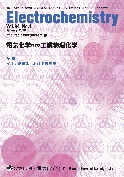All issues

Predecessor
Volume 84, Issue 7
Displaying 1-14 of 14 articles from this issue
- |<
- <
- 1
- >
- >|
Preface
-
Ryosuke O. SUZUKI2016 Volume 84 Issue 7 Pages 505
Published: July 05, 2016
Released on J-STAGE: July 05, 2016
JOURNAL FREE ACCESSDownload PDF (434K)
Articles
-
Chuen-Chang LIN, Shuang-Yu HUANG2016 Volume 84 Issue 7 Pages 506-510
Published: July 05, 2016
Released on J-STAGE: July 05, 2016
JOURNAL FREE ACCESSTo synthesize graphene built up from fewer layers with more defects, it was grown by chemical vapor deposition (CVD) and cooled to ambient temperatures at different cooling rates with different volume flow rates of hydrogen. Then, to add nitrogen functional groups to the surface of graphene, it was treated by radio frequency (RF) nitrogen-plasma at different power levels and periods of time. The faster the cooling rate, the higher the specific capacitance. Furthermore, the specific capacitance reached a maximum (150.5 F g−1) at the nitrogen-plasma treatment conditions (power = 100 W and period of time = 30 min). A longer periods of time and higher power resulted in higher specific capacitance except for 150 W at 30 min.View full abstractDownload PDF (1266K) -
Takahisa SUZUKI, Yu MORIMOTO2016 Volume 84 Issue 7 Pages 511-515
Published: July 05, 2016
Released on J-STAGE: July 05, 2016
JOURNAL FREE ACCESSThe rates of oxide formation and reduction at platinum catalyst in polymer electrolyte fuel cells were measured potentiostatically with various potential histories to reveal the kinetics of the reactions. Reaction rates during potential holds after an anodic or a cathodic sweep were examined as a function of potential and PtOH-equivalent oxide coverage. At 500 and 600 mV vs. RHE, the oxide coverage increased or decreased with increasing time depending on the potential history; this result indicates that the surfaces with different potential histories have different surface states. Oxide reduction rates were compared by changing potential and duration for oxide formation to attain the same coverage before the reduction. Oxide formed at a higher potential for a shorter period of time was easier to reduce than oxide formed at a lower potential for a longer period of time. This indicates that the oxide-formation potential and/or oxide-formation time are factors to determine the oxide reduction rate.View full abstractDownload PDF (2487K) -
Wei LUO, Junhong ZHANG, Zhipeng CHEN, Ying ZHU, Liming GAO, Ming LI2016 Volume 84 Issue 7 Pages 516-522
Published: July 05, 2016
Released on J-STAGE: July 05, 2016
JOURNAL FREE ACCESSA model for copper electrodeposition of Through-Silicon vias (TSV) is proposed based on the competitive adsorption of additives, with special emphasis on the potential drop caused by additives adsorption. The model is applicable for 2-component (accelerator and suppressor) copper plating chemistries with different concentration of accelerator. Numerical simulation is performed for the partially filling of 20 µm (diameter) × 90 µm (height) vias. Simulated copper profiles and the corresponding dependencies on potential drop are confronted with existing experimental results which were linked to potential range of small peak in Linear Sweep Voltammetry (LSV) curves.View full abstractDownload PDF (4182K)
Topic
-
Masashi OKUBO, Takashi YANAGISHITA2016 Volume 84 Issue 7 Pages 523
Published: July 05, 2016
Released on J-STAGE: July 05, 2016
JOURNAL FREE ACCESSDownload PDF (183K) -
Yuki ORIKASA2016 Volume 84 Issue 7 Pages 524-528
Published: July 05, 2016
Released on J-STAGE: July 05, 2016
JOURNAL FREE ACCESSDownload PDF (3490K) -
Daisuke ASAKURA, Eiji HOSONO2016 Volume 84 Issue 7 Pages 529-533
Published: July 05, 2016
Released on J-STAGE: July 05, 2016
JOURNAL FREE ACCESSDownload PDF (2167K) -
Masaaki HIRAYAMA, Kota SUZUKI, Ryoji KANNO, Masao YONEMURA2016 Volume 84 Issue 7 Pages 534-539
Published: July 05, 2016
Released on J-STAGE: July 05, 2016
JOURNAL FREE ACCESSDownload PDF (1623K)
-
Tokujiro NISHIKIORI, Hiroyuki TSUJIMURA, Yasuhiko ITO2016 Volume 84 Issue 7 Pages 540-549
Published: July 05, 2016
Released on J-STAGE: July 05, 2016
JOURNAL FREE ACCESSDownload PDF (4370K)
-
Susumu KUWABATA, Yukari SATO, Tetsuya TSUDA2016 Volume 84 Issue 7 Pages 550-555
Published: July 05, 2016
Released on J-STAGE: July 05, 2016
JOURNAL FREE ACCESSDownload PDF (3611K) -
Tatsuo HORIBA2016 Volume 84 Issue 7 Pages 556-557
Published: July 05, 2016
Released on J-STAGE: July 05, 2016
JOURNAL FREE ACCESSDownload PDF (826K)
Salon
-
Yusuke ITO2016 Volume 84 Issue 7 Pages 558-559
Published: July 05, 2016
Released on J-STAGE: July 05, 2016
JOURNAL FREE ACCESSDownload PDF (1159K)
-
2016 Volume 84 Issue 7 Pages 560-566
Published: July 05, 2016
Released on J-STAGE: July 05, 2016
JOURNAL FREE ACCESSDownload PDF (1253K) -
2016 Volume 84 Issue 7 Pages 568
Published: July 05, 2016
Released on J-STAGE: December 27, 2023
JOURNAL FREE ACCESSDownload PDF (645K)
- |<
- <
- 1
- >
- >|